In 1970, Senator Gaylord Nelson, a democrat from Wisconsin, set out to solidify the celebration of Earth Day. Senator Nelson felt the population and environmental concerns went hand-in-hand. He said, “The bigger the population gets, the more serious the problems become.” At the time, most people didn’t see the importance of conservation and environmentalism, what with the Vietnam War and the Civil Rights movement causing unrest. The focus was on human rights, politics, and the belief that industrialization was more pertinent to growth than ‘saving the trees.’
We Only Have One Earth

Environmentalism was not a popular practice, but after seeing youth protests of the Vietnam War in 1969, Senator Nelson wanted to bring concerns about the environment into public consciousness, so he set out to commemorate April 22 as a day to become environmentally conscious and focused on making the world a better place.
However, Senator Nelson struggled to attain the interest of the public and the press, not to mention the lawmakers. Very few organizations saw the importance of the teach-ins that were happening in other parts of the world. Senator Nelson felt an urgency to impress upon the United States how imperative it was to begin taking care of the environment in order to avoid further destruction of the world’s resources.
Once Senator Nelson was able to convince the public and the press about the significance of environmental issues, lawmakers began to jump on board the Earth Day train. The first Earth Day was April 22, 1970, and it expanded to a worldwide celebration in 1990. According to AOL.com, 141 countries with over 200 million participants set the day aside to celebrate making the world a better place. Trees were planted, school children were taught the importance of taking care of the earth, and the importance of educating the public on environmental concerns was at the forefront.
Earth Day Is Celebrated Worldwide
Earth Day continues to be celebrated every April 22. Schools and universities alike, worldwide, make it a priority to instill in students and community members the significance of conservation and environmental sciences. Many opportunities exist for communities to come together to make their little corners of the world better places by organizing trash pick up, planting flowers and shrubs that encourage bees to populate the areas, or generating recycling programs. Greater priority continues to be given to the broader implications and sense of urgency of the environmental crisis at hand.
Prioritizing the importance of taking care of our Earth should continue year-round. If everyone did their part to recycle, cut back on pollution, ensure the conservation of natural resources, and most importantly, pass these priorities on to future generations, we will have a world to enjoy for years to come.








